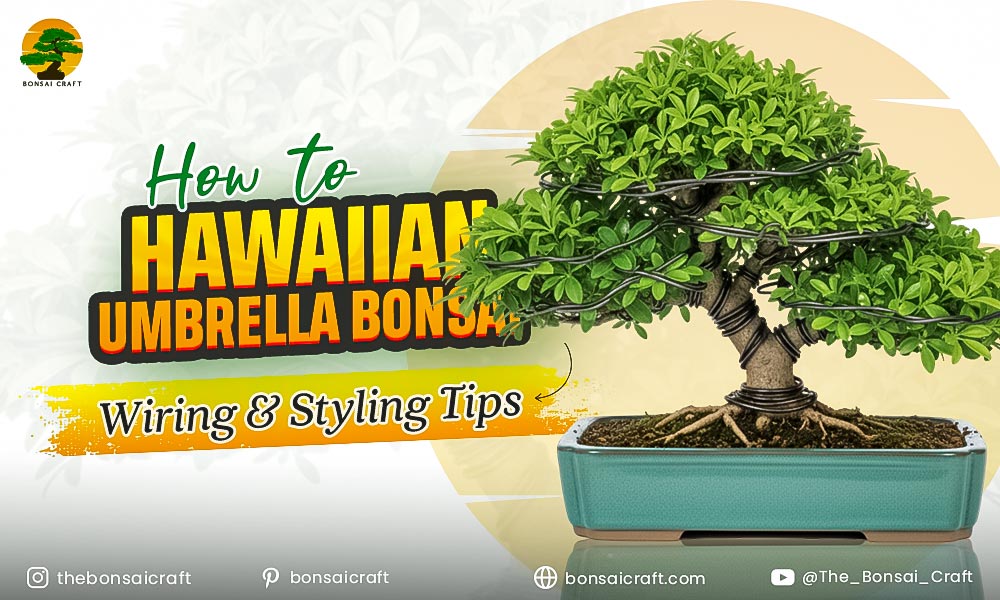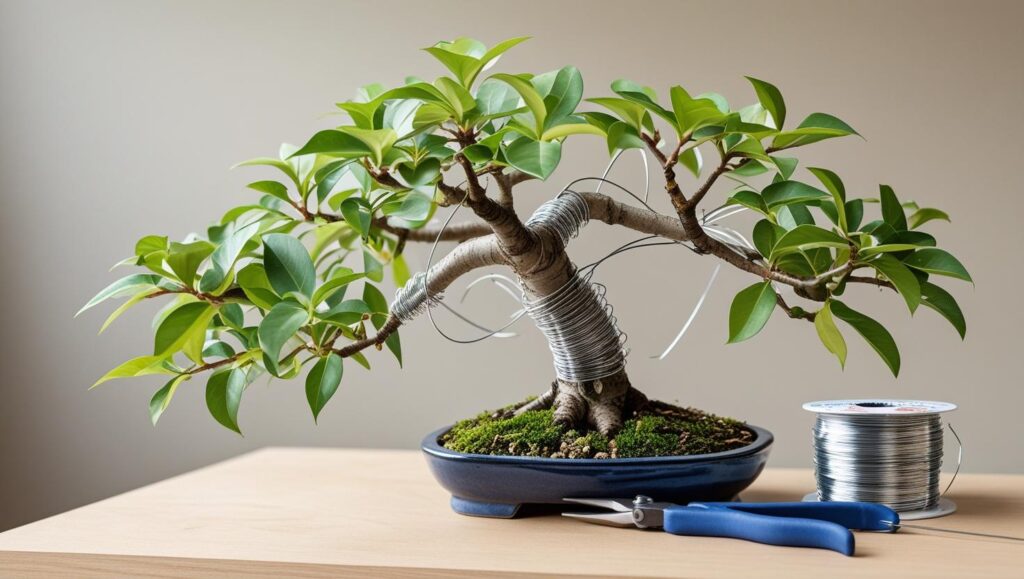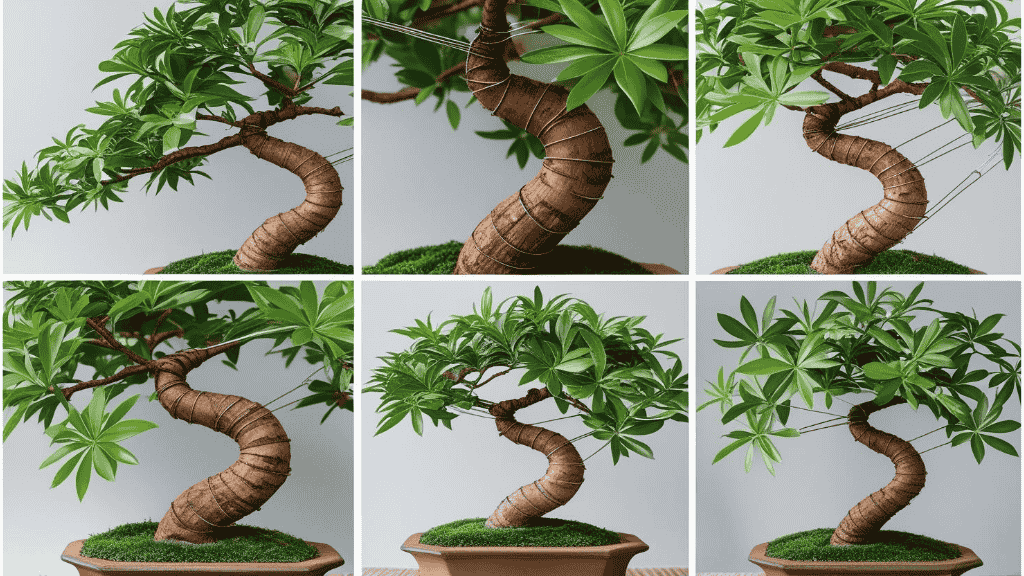
To train and style a Hawaiian Umbrella Bonsai wiring, start during its growing season (spring or early summer), using aluminum or copper wire to shape the branches into the desired position. Begin at the trunk and wrap the wire smoothly, bending branches gently to prevent them from breaking. Regularly thin and position leaves as you shape the canopy. This styling tool helps promote growth, structure, and the balance of any bonsai.
How to Begin Hawaiian Umbrella Bonsai Wiring and Styling
Bonsai trees are a joy to cultivate, but turning them into perfect, miniaturized masterpieces requires time and care. If you’re thinking about getting a Hawaiian Umbrella Bonsai, you’re in for a treat! These little trees have lush, glossy leaves and sturdy branches that thrive indoors. With proper care, your Hawaiian Umbrella Bonsai will be a beautiful addition to your home.
In this guide, we’ll cover everything you need to know in your bonsai tree shaping guide, from how to wire a bonsai tree step by step to mastering bonsai styling techniques. Whether you’re a beginner or an experienced grower, this guide will show you how to wire your tree, shape it, and keep it looking amazing. Let’s dive in!
Understanding Hawaiian Umbrella Bonsai Structure for Wiring
What is a Hawaiian Umbrella Bonsai?
The Hawaiian Umbrella Bonsai (Schefflera arboricola) is a tropical plant known for its glossy, umbrella-shaped leaves. It’s perfect for bonsai enthusiasts because it thrives indoors. While it can grow taller in nature, as a bonsai, it stays small and can be easily shaped.
With the right care, your Hawaiian Umbrella Bonsai will remain a beautiful treasure for years to come, with a thick trunk, healthy branches, and a lush canopy.
The Ideal Structure for Hawaiian Umbrella Bonsai Wiring
Before diving into bonsai styling techniques like wiring, it’s important to understand the natural structure of your tree. The Hawaiian Umbrella Bonsai has certain features that help it achieve the best look. Knowing how to work with these features will make it easier to shape:
- Trunk: You’ll need a strong, thick trunk to support the tree while you perform Hawaiian Umbrella Bonsai wiring.
- Branches: The branches should be evenly placed to ensure balance and aesthetics.
- Leaves: While the leaves are crucial for the tree’s health, trimming them helps improve light reception and shape the early structure of the branches.
How to Wire a Hawaiian Umbrella Bonsai: Step-by-Step Wiring Guide
What You Will Need for Bonsai Wiring
Before starting the Hawaiian Umbrella Bonsai wiring, gather the following tools to make the process smoother:
- Wire: You can use either aluminum wire or copper wire. Aluminum wire is easy to bend and is perfect for beginners, while copper wire is stronger and works well for older trees.
- Cutting Pliers: You’ll need these to trim excess wire, branches, or roots.
- Bonsai Pliers: These help you bend the wire around the branches carefully.
- Bonsai Tray: A steady surface is important for working on your tree.
The Best Time to Wire Your Hawaiian Umbrella Bonsai
Hawaiian Umbrella Bonsai wiring is best done during the tree’s growing season, which is typically spring or early summer. During this time, the branches are softer and more pliable, making them easier to bend without snapping them off.
Signs your tree is ready for wiring:
- New, healthy growth
- Soft, pliable branches
- Slightly flexible woody branches
How to Wire Bonsai Branches: A Simple Step-by-Step Guide
Now that you have everything ready, here’s a simple, step-by-step guide for how to wire a bonsai tree step by step:
- Pick the Right Wire: Choose a wire that’s about one-third the diameter of the branch. This will help the wire stay in place without damaging the bark.
- Start at the Trunk: Secure the wire at the bottom of the trunk, then begin wrapping it around the major branches.
- Wrap the Branches: Carefully wrap the wire around the branches, following their natural growth direction. Don’t wrap too tightly—this could damage the bark.
- Bend the Branches: With the wire in place, gently bend the branches toward your desired position. Move slowly—don’t rush this step!
- Place the Canopy: After bending the branches, adjust them to create a balanced canopy. If needed, add more wire to fine-tune the angles.
Training Your Hawaiian Umbrella Bonsai Using Wiring Techniques
Once the wire is in place, leave it alone and let the branches settle into their new positions. Regularly check to make sure the wire isn’t cutting into the bark. If needed, replace it with a looser wire as the branches grow.
- Bend Gradually: Take it slow when bending the branches. You don’t want to bend too many at once, as this could cause them to snap.
How to Style Your Hawaiian Umbrella Bonsai Tree with Wiring
Guiding Your Hawaiian Umbrella Bonsai Tree: Trunk and Branch Placement
Shaping your Hawaiian Umbrella Bonsai starts with the trunk and branches. You can create a twist or an S-curve in the trunk to give it an interesting look. Start by spreading the main branches around the trunk, then add secondary branches.
- Trunk Bending: Use the wire to gently bend the trunk into an S-shape or twist it to make it look more interesting.
- Branch Placement: Ensure the branches are evenly spaced for balance and symmetry in the tree.
How to Style the Canopy and Leaf Distribution
The canopy is the focal point of your bonsai tree. For your Hawaiian Umbrella Bonsai, make sure the leaves are spread out evenly, allowing light to reach all parts of the tree.
- Thinning Leaves: Trim some of the leaves to let light reach the lower branches and encourage healthy growth.
- Defoliation: Occasionally remove leaves to let light pass through to the lower parts of the tree and help it develop a better structure.
Beginners Guide on How to Style Your Hawaiian Umbrella Bonsai with Wiring
The Hawaiian Umbrella Bonsai is perfect for beginners because it’s forgiving and easy to shape. Here are some bonsai training tips to get you started:
- Start Small: Focus on shaping the trunk and main branches before working on the canopy.
- Prune Sparingly: Don’t over-prune. Let the tree grow naturally and only prune when necessary.
- Let It Grow Naturally: Work with the tree’s natural growth instead of forcing it into an unnatural shape.
Bonsai Wire vs Pruning: Which Method Should You Use to Shape Your Bonsai?
To Wire or Not to Wire—When to Prune
Hawaiian Umbrella Bonsai wiring and pruning go hand-in-hand. Here’s when to use each technique:
- Wire when you need to train the branches into specific shapes or positions.
- Prune to remove dead or unhealthy branches and maintain the overall health of the tree.
Avoiding Bonsai Wiring Mistakes
Here are a couple of mistakes to avoid when wiring your Hawaiian Umbrella Bonsai:
- Don’t Over-Tighten: The wire should fit snugly, but not too tightly. Over-tightening can damage the bark and harm the tree.
- Check Regularly: Make sure the wire isn’t cutting into the branches as the tree grows. If necessary, replace it with a looser, thicker wire.
Best Wire Type for Hawaiian Umbrella Bonsai
Overview of Bonsai Wire Types
There are two types of wire you can use for Hawaiian umbrella bonsai wiring: aluminum wire and copper wire. Here’s how to choose the best one for your Hawaiian Umbrella Bonsai:
- Aluminum Wire: Ideal for beginners because it’s easy to manipulate and bend.
- Copper Wire: Stronger and more durable, copper wire works better for holding branches in place on older trees.
Choosing the Right Wire Thickness
Picking the right wire thickness is important to avoid damage. Use wire that’s about one-third the thickness of the branch you’re working with to prevent cutting into the bark.
Indoor Bonsai Styling Tips for Hawaiian Umbrella Bonsai Wiring
Styling Hawaiian Umbrella Bonsai Indoors
If you’re keeping your Hawaiian Umbrella Bonsai indoors, here are a few tips to help it thrive:
- Good Light: Ensure your tree gets at least 6 hours of indirect sunlight every day.
- Humidity: Indoor air can be dry, so place your bonsai in a humidity tray or mist it regularly.
Helping Bonsai Keep Their Shape and Remain Healthy Indoors
Indoor bonsai need a little more attention:
- Watering: Make sure the soil drains well and only water when it feels dry to the touch.
- Prune Sparingly: Indoor bonsai grow more slowly, so avoid over-pruning.
In Conclusion: How to Style Hawaiian Umbrella Bonsai
Now that you’ve learned the basics of Hawaiian Umbrella Bonsai wiring, you’re ready to start shaping your tree! Wiring is key for forming the trunk and branches, but don’t forget about pruning and general care. With a little patience and creativity, your Hawaiian Umbrella Bonsai will soon be a beautiful addition to your space. Happy growing!
FAQs
How long should I leave the wire on my Hawaiian Umbrella Bonsai?
Answer: Generally, leave the wire on your Hawaiian Umbrella Bonsai for 6–8 weeks. Regularly check that the wire isn’t cutting into the bark, and remove or adjust it as the branches set into their new shape.
Can I wire a Hawaiian Umbrella Bonsai during winter?
Answer: It’s not recommended. Hawaiian Umbrella Bonsai wiring is best done in spring or early summer when the branches are flexible. Wiring in winter may cause branch breakage or stress due to slower sap flow.
What style suits Hawaiian Umbrella Bonsai best?
Answer: The informal, upright and umbrella-style canopies are most popular. These styles highlight the tree’s natural structure and glossy leaves, making them ideal for indoor bonsai displays.


